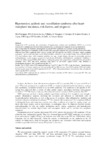Hypotension, acidosis and vasodilation syndrome after heart transplant: incidence, risk factors, and prognosis

Ver/Abrir
Use este enlace para citar
http://hdl.handle.net/2183/15400Colecciones
- Investigación (FEP) [514]
Metadatos
Mostrar el registro completo del ítemTítulo
Hypotension, acidosis and vasodilation syndrome after heart transplant: incidence, risk factors, and prognosisAutor(es)
Fecha
2003-08-30Cita bibliográfica
Paniagua MJ, Crespo-Leiro MG, Muñiz J, Vázquez E, Tabuyo T, Castro-Orjales M, et al. Hypotension, acidosis and vasodilation syndrome after heart transplant: incidence, risk factors, and prognosis. Transplant Proc. 2003;35(5):1957-1958
Resumen
[Abstract] Background. HAV syndrome, the combination of hypotension, acidosis and vasodilation (HAV), is a serious postoperative complication after heart transplantation (HT). Its etiology and prognosis are poorly understood.
Aim. To determine the incidence and prognosis of post-HT HAV syndrome and examine possible risk factors.
Methods. Retrospective examination of the records of 85 consecutive patients who underwent HT between December 1999 and June 2002 sought the HAV criteria: systolic BP <85 mm Hg plus HCO3 <19 mEq/l whole excluding cardiogenic, hypovolemic and septic shock. Donor variables included sex, age, weight, height, cause of death, time in ICU, and ischemic time; while recipient variables, sex, age, weight, height, etiology of cardiopathy, previous cardiopulmonary bypass surgery, preoperative amiodarone, β-blockers, catecholamines, mechanical ventilation or intra aortic balloon pump (IABP), RVP, time on waiting list, pump time, reoperations, polytransfusion, preoperative creatinine, GOT, GPT and GGT, induction with OKT3 or anti-CD25, bypass-to-HAV time, duration of catecholamine treatment, and 1 month survival after HT.
Results. The 11 HAV cases (13%) appeared between 1 and 72 h after HT (75% in the first hour). Catecholamines were used for 1 to 6 days; control was achieved within 48 h in 58% of cases. Two HAV patients (18%) died within the first month versus six non-HAV patients (8.1%) (P = .275). Only polytransfusion showed more than a borderline value to predict HAV syndrome.
Conclusions. HAV syndrome has an incidence of 13% and a mortality of 18% within 1 month post-HT. The only likely risk factor is polytransfusion.
Versión del editor
Derechos
Creative Commons Licence Reconocimiento-NoComercial-SinObraDerivada 4.0 Internacional






